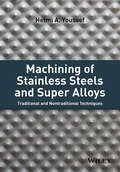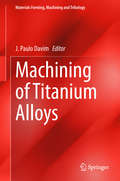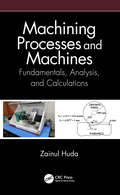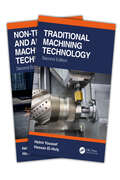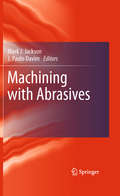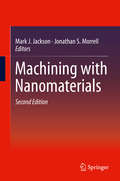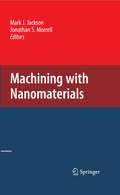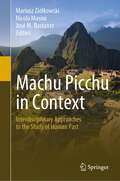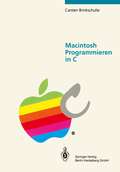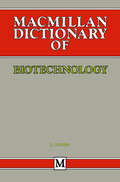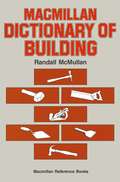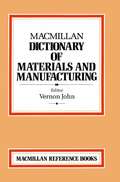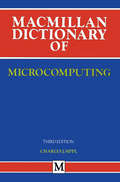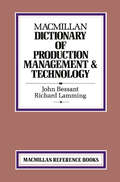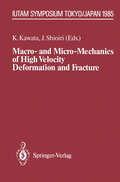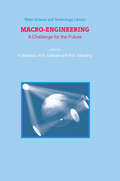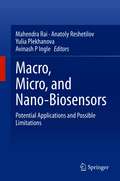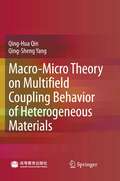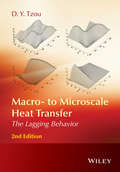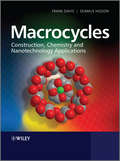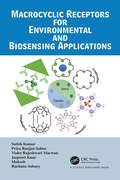- Table View
- List View
Machining of Stainless Steels and Super Alloys: Traditional and Nontraditional Techniques
by Helmi A. YoussefProvides a comprehensive description for machining technologies of stainless steels and super alloys with consideration to current industrial applications. Presents current and recent developments related to traditional and nontraditional machining techniques of stainless steels and super alloys Arranges types of stainless steels and super alloys in qualitative and quantitative form, as related to their machining characteristics, providing the reader with information regarding optimum working condition for each material Proposes a 10-level machinability chart to rank important grades of stainless steels Arranges the machinability rating of the most commonly used super alloys in a descending order Presents non-traditional machining processes along with some hybrid processes which have been applied successfully to stainless steels and super alloys
Machining of Stainless Steels and Super Alloys: Traditional and Nontraditional Techniques
by Helmi A. YoussefProvides a comprehensive description for machining technologies of stainless steels and super alloys with consideration to current industrial applications. Presents current and recent developments related to traditional and nontraditional machining techniques of stainless steels and super alloys Arranges types of stainless steels and super alloys in qualitative and quantitative form, as related to their machining characteristics, providing the reader with information regarding optimum working condition for each material Proposes a 10-level machinability chart to rank important grades of stainless steels Arranges the machinability rating of the most commonly used super alloys in a descending order Presents non-traditional machining processes along with some hybrid processes which have been applied successfully to stainless steels and super alloys
Machining of Titanium Alloys: Aluminum, Titanium, And Magnesium (Materials Forming, Machining and Tribology)
by J. Paulo DavimThis book presents a collection of examples illustrating the resent research advances in the machining of titanium alloys. These materials have excellent strength and fracture toughness as well as low density and good corrosion resistance; however, machinability is still poor due to their low thermal conductivity and high chemical reactivity with cutting tool materials. This book presents solutions to enhance machinability in titanium-based alloys and serves as a useful reference to professionals and researchers in aerospace, automotive and biomedical fields.
Machining Processes and Machines: Fundamentals, Analysis, and Calculations
by Zainul HudaMachining is one of the eight basic manufacturing processes. This textbook covers the fundamentals and engineering analysis of both conventional and advanced/non-traditional material removal processes along with gear cutting/manufacturing and computer numerically controlled (CNC) machining. The text provides a holistic understanding of machining processes and machines in manufacturing; it enables critical thinking through mathematical modeling and problem solving, and offers 200 worked examples/calculations and 70 multiple choice questions on machining operations, as well as on CNC machining, with the eBook version offered in color. This unique book is equally useful to both engineering degree students and production engineers practicing in the manufacturing industry.
Machining Processes and Machines: Fundamentals, Analysis, and Calculations
by Zainul HudaMachining is one of the eight basic manufacturing processes. This textbook covers the fundamentals and engineering analysis of both conventional and advanced/non-traditional material removal processes along with gear cutting/manufacturing and computer numerically controlled (CNC) machining. The text provides a holistic understanding of machining processes and machines in manufacturing; it enables critical thinking through mathematical modeling and problem solving, and offers 200 worked examples/calculations and 70 multiple choice questions on machining operations, as well as on CNC machining, with the eBook version offered in color. This unique book is equally useful to both engineering degree students and production engineers practicing in the manufacturing industry.
Machining Technology and Operations: 2-Volume Set
by Helmi Youssef Hassan El-HofyThis two-volume set addresses both current and developing topics of advanced machining technologies and machine tools used in industry. The treatments are aimed at motiving and challenging the reader to explore viable solutions to a variety of questions regarding product design and optimum selection of machining operations for a given task. This two-volume set will be useful to professionals, students, and companies in the areas of mechanical, industrial, manufacturing, materials, and production engineering fields. Traditional Machining Technology covers the technologies, machine tools, and operations of traditional machining processes. These include the general-purpose machine tools used for turning, drilling, and reaming, shaping and planing, milling, grinding and finishing operations. Thread and gear cutting, and broaching processes are included along with semi-automatic, automatic, NC and CNC machine tools, operations, tooling, mechanisms, accessories, jigs and fixtures, and machine tool dynamometry are discussed. Non-Traditional and Advanced Machining Technologies covers the technologies, machine tools, and operations of non-traditional mechanical, chemical and thermal machining processes. Assisted machining technologies, machining of difficult-to-cut materials, design for machining, accuracy and surface integrity of machined parts, environment-friendly machine tools and operations, and hexapods are also presented. The topics covered throughout this volume reflect the rapid and significant advances that have occurred in various areas in machining technologies.
Machining with Abrasives
by Mark J. Jackson and J. Paulo DavimAbrasive machining is one of the most important processes used in manufacturing engineering to remove unwanted material and to obtain the desired geometry and surface quality. Abrasive machining processes are processes where material is removed from a work piece using a multitude of hard angular abrasive particles or grains which may or may not be bonded to form a tool. Abrasive Machining discusses the fundamentals and advances in the abrasive machining processes, and provides a complete overview of the newly developing areas in the field including but not limited to, high efficiency deep grinding and micro and nanogrinding.
Machining with Nanomaterials
by Mark J. Jackson Jonathan S. MorrellThis book focuses on the state-of-the-art developments in machining with nanomaterials. Numerous in-depth case studies illustrate the practical use of nanomaterials in industry, including how thin film nanostructures can be applied to solving machining problems and how coatings can improve tool life and reduce machining costs in an environmentally acceptable way. Chapters include discussions on, among other things:Comparisons of re-coated cutting tools and re-ground drillsThe modeling and machining of medical materials, particularly implants, for optimum biocompatibility including corrosion resistance, bio adhesiveness, and elasticityRecent developments in machining difficult-to-cut materials, as well as machining brittle materials using nanostructured diamond toolsSpindle Speed Variation (SSV) for machining chatter suppressionNano grinding with abrasives to produce micro- and nano fluidic devices.The importance of proper design of cutting tools, including milling tools, single point turning tools, and micro cutting tools is reinforced throughout the book. This is an ideal book for engineers in industry, practitioners, students, teachers, and researchers.
Machining with Nanomaterials
by Mark J. Jackson Jonathan S. Morrell“Machining with Nanomaterials” focuses on the application of thin film nanostructures to the solution of machining problems. The solution to machining materials in an environmentally conscious manner is to use newly developed thin film superlattice layer coatings that provide a means to eliminate the use of flood cooling and the associated peripheral equipment. The practical significance of the development of these coatings is related to eliminating the need for cooling and lubrication by fluids and the need to machine at ever increasing cutting speeds. The effects of reducing tool life is a particular challenge in high speed machining, and this text explains how coatings can improve tool life, reduce machining costs, and machine in an environmentally acceptable way.
Machu Picchu in Context: Interdisciplinary Approaches to the Study of Human Past
by Nicola Masini Mariusz Ziółkowski José M. BastanteThis book aims at integrating archaeology with science in order to provide additional information with respect to a traditional archaeological anthropological perspective. It sheds light on Incan culture, the relation between human frequentation and environmental changes, the Incan architecture in relation with Andean cosmovision using, for the first time, diverse technological and scientific approaches including LiDAR remote sensing, geophysics and radio carbon dating. A number of recent studies conducted by Polish, Italian and Peruvian scientific missions in Machu Picchu, Chachabamba and Cusco are presented and discussed.Chapter 5 is available open access under a Creative Commons Attribution-ShareAlike 4.0 International License via link.springer.com.
Macmillan Dictionary of Building (Dictionary Series)
This dictionary is designed as a companion for anyone who works in the construction industry, and for the many students who study building, surveying or civil engineering. The book should also be helpful to everyone who needs to describe the building they live in.
Macro- and Micro-Mechanics of High Velocity Deformation and Fracture: IUTAM Symposium on MMMHVDF Tokyo, Japan, August 12–15, 1985 (IUTAM Symposia)
by Kozo Kawata Jumpei ShioiriThe IUTAM Symposium on Macro- and Micro-Mechanics of High Velocity Deformation and Fracture (MMMHVDF) (August 12 - 15, 1985) was held at Science Council of Japan, under the sponsor ship of IUTAM, Science Council of Japan, Japan Society for the Promotion of Science, The Commemorative Association for the Japan World Exposition (1970), and The Japan Society for Aeronautical and Space Sciences. The proposal of the symposium was accepted by the General Assembly of IUTAM, and the scientists mentioned below were appointed by the Bureau of IUTAM to serve as member of the Scientific Committee. The main object of the Symposium was to make a general survey of recent developments in the re search of high velocity solid mechanics and to explore further new ideas for dealing with unsettled problems, of fundamental nature as well as of practical importance. The subjects covered theoretical, experimental, and numerical fields in macro- and micro-mechanics associated with high velocity de formatio~ and fracture in soldis, covering metals, ceramics, polymers, and composites.
Macro-Engineering: A Challenge for the Future (Water Science and Technology Library #54)
by V. Badescu R. B. Cathcart R. D. SchuilingMacro-engineering involves the large-scale modification and manipulation of natural systems for the benefit of mankind. The primary goals of some Earth-based macroprojects described in this book are power production, land reclamation, food production, climate change, water, transport and coastal protection. Other Earth or space projects considered here have a more futuristic ring, but our present-day technical skill makes their realization possible.
Macro, Micro, and Nano-Biosensors: Potential Applications and Possible Limitations
by Mahendra Rai Anatoly Reshetilov Yulia Plekhanova Avinash P. IngleThis book includes an international group of researchers who present the latest achievements in the field of enzyme, immune system, and microbial and nano-biosensors. It highlights the experimental evidence for formation of biological fuel cells (BFCs)-which has a dual purpose – as a device that produces electricity and the systems which produce it simultaneously cleaning up the environment from polluting organic compounds. Considering the work in the field of macro, micro and nano-biosensors, considerable attention is paid to the use of nanomaterials for the modification of working electrodes. Nanomaterials in some cases can significantly improve the parameters of analytical systems. Readers will be interested in the projection of the presented theoretical and experimental materials in the field of practical application of modern analytical developments. The presented results in many cases imply the possibility of using the created models of macro, micro and nano-biosensors, and biofuel elements in the field of health, and protection/restoration of the environment. It includes information about all existing types of transducers of signals in biosensors – electrochemical, optical and quantum-optics, thermoelectric, data of atomic force microscopy, piezoelectric, and more. On the basis of these principles, descriptions are given about the functioning of macro, micro and nano- biosensors for the detection of compounds used in medicine, detection of compounds that clog the environment, and thus affect human health, for compounds that are potentially the basis for the production of drugs, for the selection of compounds that have medicinal activity, for immunodetection, and to assess the quality of food. These questions form the basis of research carried out in the field of biosensors in the world. Since the described models of biosensors have high sensitivity, high measurement speed and selectivity, the described results attract the attention of both the ordinary reader and business class specialists who create and implement analytical technologies. This book is very useful for researchers in life sciences, chemical sciences, physics, and engineering. In addition, it will be useful for the persons working in industry. Advanced technologies specialists will be attracted by the novelty of the proposed solutions and their relevance and ease of implementation. Since the studies contain sections describing the parameters of different biosensors, BFCs, they are easily navigated into assessing the effectiveness of the practical use of the proposed device. The relevant sections indicate such characteristics as detection ranges, life span, type of biological material used, the method of formation of the bio-receptor part. These parameters are of interest to both developers of new models of biosensors and BFC, and their manufacturers.
Macro-Micro Theory on Multifield Coupling Behavior of Heterogeneous Materials
by Qinghua Qin Qing-Sheng YangMacro-Micro Theory on Multifield Coupling Behavior of Heterogeneous Materials discusses high performance structures using macro-micro theories and a micromechanics approach. The monograph is intended for specialists in materials science and applied mechanics. Qing-Hua Qin is a professor at The Australian National University, Canberra, and has been in the area of applied mechanics for more than two decades. Professor Qing-Sheng Yang at Beijing University of Technology focuses his research interests at composites micromechanics, structural analysis and multifield coupling behavior of polymers and biomaterials.
Macro- to Microscale Heat Transfer: The Lagging Behavior
by D. Y. TzouPhysical processes taking place in micro/nanoscale strongly depend on the material types and can be very complicated. Known approaches include kinetic theory and quantum mechanics, non-equilibrium and irreversible thermodynamics, molecular dynamics, and/or fractal theory and fraction model. Due to innately different physical bases employed, different approaches may involve different physical properties in describing micro/nanoscale heat transport. In addition, the parameters involved in different approaches, may not be mutually inclusive. Macro- to Microscale Heat Transfer: The Lagging Behavior, Second Edition continues the well-received concept of thermal lagging through the revolutionary approach that focuses on the finite times required to complete the various physical processes in micro/nanoscale. Different physical processes in heat/mass transport imply different delay times, which are common regardless of the material type. The delay times, termed phase lags, are characteristics of materials. Therefore the dual-phase-lag model developed is able to describe eleven heat transfer models from macro to nanoscale in the same framework of thermal lagging. Recent extensions included are the lagging behavior in mass transport, as well as the nonlocal behavior in space, bearing the same merit of thermal lagging in time, in shrinking the ultrafast response down to the nanoscale. Key features: Takes a unified approach describing heat and mass transport from macro, micro to nanoscale Compares experimental results for model validation Includes easy to follow mathematical formulation Accompanied by a website hosting supporting material Macro- to Microscale Heat Transfer: The Lagging Behavior, Second Edition is a comprehensive reference for researchers and practitioners, and graduate students in mechanical, aerospace, biological and chemical engineering.
Macrocycles: Construction, Chemistry and Nanotechnology Applications
by Frank Davis Séamus HigsonMacrocyclic molecules contain rings made up of seven or more atoms. They are interesting because they provide building blocks for synthesizing precise two or three dimensional structures – an important goal in nanotechnology. For example, they can be used to develop nanosized reaction vessels, cages, switches and shuttles, and have potential as components in molecular computers. They also have applications as catalysts and sensors. Macrocycles: Construction, Chemistry and Nanotechnology Applications is an essential introduction this important class of molecules and describes how to synthesise them, their chemistry, how they can be used as nanotechnology building blocks, and their applications. A wide range of structures synthesised over the past few decades are covered, from the simpler cyclophanes and multi-ring aromatic structures to vases, bowls, cages and more complex multi-ring systems and 3D architectures such as “pumpkins”, interlocking chains and knots. Topics covered include: principles of macrocycle synthesis simple ring compounds multi-ring aromatic structures porphyrins and phthalocanines cyclophanes crown ethers, cryptands and spherands calixarenes, resorcinarenes, cavitands, carcerands, and heterocalixarenes cyclodextrins cucurbiturils cyclotriveratylenes rotaxanes catenanes complex 3D architectures, including trefoils and knots Macrocycles: Construction, Chemistry and Nanotechnology Applications distills the essence of this important topic for undergraduate and postgraduate students, and for researchers in other fields interested in getting a general insight into this increasingly important class of molecules.
Macrocycles: Construction, Chemistry and Nanotechnology Applications
by Frank Davis Séamus HigsonMacrocyclic molecules contain rings made up of seven or more atoms. They are interesting because they provide building blocks for synthesizing precise two or three dimensional structures – an important goal in nanotechnology. For example, they can be used to develop nanosized reaction vessels, cages, switches and shuttles, and have potential as components in molecular computers. They also have applications as catalysts and sensors. Macrocycles: Construction, Chemistry and Nanotechnology Applications is an essential introduction this important class of molecules and describes how to synthesise them, their chemistry, how they can be used as nanotechnology building blocks, and their applications. A wide range of structures synthesised over the past few decades are covered, from the simpler cyclophanes and multi-ring aromatic structures to vases, bowls, cages and more complex multi-ring systems and 3D architectures such as “pumpkins”, interlocking chains and knots. Topics covered include: principles of macrocycle synthesis simple ring compounds multi-ring aromatic structures porphyrins and phthalocanines cyclophanes crown ethers, cryptands and spherands calixarenes, resorcinarenes, cavitands, carcerands, and heterocalixarenes cyclodextrins cucurbiturils cyclotriveratylenes rotaxanes catenanes complex 3D architectures, including trefoils and knots Macrocycles: Construction, Chemistry and Nanotechnology Applications distills the essence of this important topic for undergraduate and postgraduate students, and for researchers in other fields interested in getting a general insight into this increasingly important class of molecules.
Macrocyclic Receptors for Environmental and Biosensing Applications
by Satish Kumar Jaspreet Kaur Priya Ranjan Sahoo Violet Rajeshwari Macwan Mukesh Rachana SahneyThe book is designed to highlight the utility of supramolecular systems in diverse areas such as sensing of ionic and molecular analytes, aggregation, artificial molecular machines, biology, and medicine. The synthetic chemistry of a diverse set of supramolecules encompassing various supramolecular interactions involved in driving macrocyclic architectures is discussed. Attempts have been made to cover unique features of macrocycles viz. control over shape, size, and valency along with supramolecular interactions, which direct complex supramolecular systems. The book also provides a discussion on the similarity between macrocyclic host-guest systems and biomolecules, which lay the foundation of building modern artificial molecular motors and switches like protein machines for application in diverse areas. The authors hope that the book will appeal to a wider audience of students and researchers in academics and/or industries.
Macrocyclic Receptors for Environmental and Biosensing Applications
by Satish Kumar Jaspreet Kaur Priya Ranjan Sahoo Violet Rajeshwari Macwan Mukesh Rachana SahneyThe book is designed to highlight the utility of supramolecular systems in diverse areas such as sensing of ionic and molecular analytes, aggregation, artificial molecular machines, biology, and medicine. The synthetic chemistry of a diverse set of supramolecules encompassing various supramolecular interactions involved in driving macrocyclic architectures is discussed. Attempts have been made to cover unique features of macrocycles viz. control over shape, size, and valency along with supramolecular interactions, which direct complex supramolecular systems. The book also provides a discussion on the similarity between macrocyclic host-guest systems and biomolecules, which lay the foundation of building modern artificial molecular motors and switches like protein machines for application in diverse areas. The authors hope that the book will appeal to a wider audience of students and researchers in academics and/or industries.
